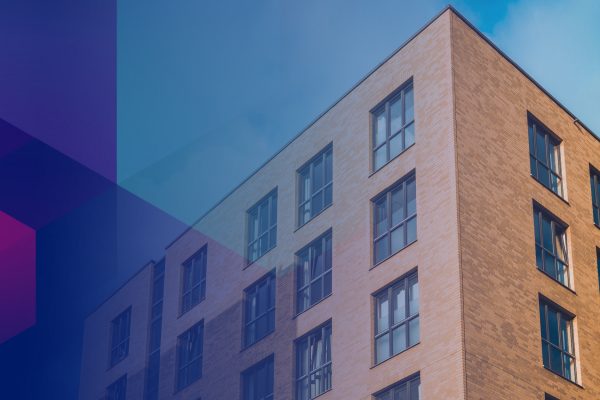Not All Multifamily Assets are Created Equal
Leveraging Tenant Credit Profile to distinguish between seemingly similar multifamily assets

In today’s challenging environment, it is critical for lenders and investors to equip themselves with the data required to accurately forecast multifamily operating metrics.
Asset-level data such as year of construction, net operating income, and occupancy have historically been indicative of a building’s future performance.
However, those data are lagging and are insufficient for predicting future rent collections for a specific property during times of heightened market uncertainty. The data traditionally utilized by multifamily practitioners don’t provide insight into the current financial health of tenants that reside in a given building.
GeoPhy’s Tenant Credit Profile (TCP) reports consumer credit metrics that have been aggregated at the multifamily building level. Lenders and investors now have access to key leading indicators for future rent collections such as average tenant credit score, the percentage of tenants that are delinquent on a loan or line of credit, and credit card utilization rates.
We designed TCP to help lenders and investors differentiate multifamily assets that are likely to become distressed from stable assets. The following analysis demonstrates how TCP can be used to distinguish between two seemingly similar properties based on aggregated tenant credit behavior.
A Tale of Two Buildings
The subjects of this analysis are two multifamily buildings in Portland, OR. The properties are located on the same street and in the same ZIP code. They are approximately 0.5 miles apart from one another and both have less than 40 units. The GeoPhy Neighborhoods ratings for Building 1 and Building 2 are a very similar 67 and 68 out of 563 in the Portland Metro area. On the surface, one might expect these two assets to perform comparably over the coming months.
TCP data, however, tells a much different story.
Chart 1 displays the median tenant credit score for each building between December 2019 and September 2020. (We’ve redacted the buildings’ addresses to preserve the privacy of the tenants and building owners.)
Building 1’s median score has been relatively stable and has actually improved since the beginning of the COVID-19 pandemic.
Building 2, on the other hand, has seen its median score significantly decline from 692 in December 2019, to 610 in September, 2020. Remember that a decrease of 30 points in credit scores represents a doubling of the risk of default. In addition, Building 2’s median tenant credit score has dropped below the median score for other renters in the broader Portland metro area.
Interestingly, in December 2019, the tenants in Buildings 1 and 2 had median credit scores of 681 and 692, respectively. While the Building 2 tenants appear to have been more stable than their Building 1 counterparts pre-COVID, they have become financially stressed over the last nine months.

Tenant Default Rates
Chart 2 displays the percent of tenants in each building that are 30+ days past due on one or more of their debt payments.
The delinquency rate for Building 1’s tenants has remained relatively stable while the rate for Building 2’s tenants has increased dramatically since March 2020. In fact, the percent of tenants in Building 2 that are 30+ days behind on their bills has gone from 32% in March 2020 to 44% in September 2020. This means that 12% of the tenants that reside in Building 2 have experienced a material change in financial circumstance since March 2020.
As noted in a previous blog post, distressed consumers typically stop making payments on credit cards and auto loans prior to defaulting on their mortgage or rent payments. In general, maintaining a stable living environment is a top priority. Importantly, TCP provides insight into delinquency rates for different types of debt, which allows users to understand where tenants are in the default cycle.

Tenant Credit Utilization Rates
Chart 3 shows the average revolving debt (i.e. credit card) utilization for Building 1 and Building 2’s tenants.
Unsurprisingly, the credit utilization behavior for tenants in Building 1 is stable and at parity with other apartment renters in Portland. Utilization has actually come down since March 2020, which is consistent with national trends and is primarily attributed to the timing of COVID stimulus payments.
Conversely, the tenants in Building 2 are spending more and on average, have utilized nearly half of their available credit.
Many multifamily landlords have begun accepting credit cards as a form of rental payment, so credit utilization is an especially important metric to monitor. As utilization spikes, so do the minimum monthly payments that tenants are required to pay their credit card issuers and other lenders. It is easy to see why paying monthly rent via credit card may not be an option much longer for some renters as utilization rates increase and tenants effectively “max out” their lines of credit.

Wrapping Up
While our two Portland properties appear to be similar based on location and historical operating performance, Building 2 clearly comes with more risk for lenders and investors.
The analysis outlined above leveraged a small subset of the aggregated consumer credit data that is available via TCP. There are dozens of other attributes that are equally valuable in terms of understanding risk and forecasting key metrics such as rent collections, net operating income, occupancy, and tenant turnover expense.
Reach out to us for a demo. We’d love to show you more!
Read all of our five-part series about GeoPhy’s Tenant Credit Profile:
- Introducing GeoPhy’s Tenant Credit Profile
How aggregated credit data will transform multifamily risk management
- An Early Warning System for Multifamily Rent Collection
Tenant Credit Profile provides asset managers the ability to act before events act on them
- Not All Multifamily Assets are Created Equal
Leveraging Tenant Credit Profile to distinguish between seemingly similar multifamily assets
- Improving Sales Comp Selection
Tenant Credit Profile adds a crucial layer to finding the “perfect” comp
- Tracking Multifamily Tenant Financial Health
GeoPhy’s Tenant Credit Profile reveals varying conditions between regions and building types


